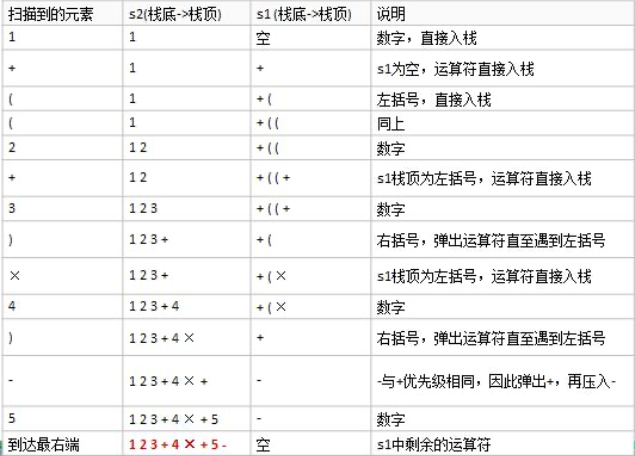中缀表达式转换为后缀表达式(Java)
博客说明
文章所涉及的资料来自互联网整理和个人总结,意在于个人学习和经验汇总,如有什么地方侵权,请联系本人删除,谢谢!
步骤
-
初始化两个栈:运算符栈 s1 和储存中间结果的栈 s2
-
从左至右扫描中缀表达式
-
遇到操作数时,将其压 s2
-
遇到运算符时,比较其与 s1 栈顶运算符的优先级:
- 如果 s1 为空,或栈顶运算符为左括号“(”,则直接将此运算符入栈
- 否则,若优先级比栈顶运算符的高,也将运算符压入 s1;
- 否则,将 s1 栈顶的运算符弹出并压入到 s2 中,再次转到(4-1)与 s1 中新的栈顶运算符相比较;
-
遇到括号时:
- 如果是左括号“(”,则直接压入 s1
- 如果是右括号“)”,则依次弹出 s1 栈顶的运算符,并压入 s2,直到遇到左括号为止,此时将这一对括号丢弃
-
重复步骤 2 至 5,直到表达式的最右边
-
将 s1 中剩余的运算符依次弹出并压入 s2
-
依次弹出 s2 中的元素并输出,结果的逆序即为中缀表达式对应的后缀表达式
案例
将中缀表达式“1+((2+3)×4)-5”转换为后缀表达式的过程如下
因此结果为 :"123+4 × +5 –"

代码
package stack;
import java.util.ArrayList;
import java.util.List;
import java.util.Stack;
/**
* @author guizimo
* @date 2020/4/6 12:25 下午
*/
public class PolandNotation {
public static void main(String[] args) {
//表达式
String suffixExpression = "1+((2+3)*4)-5";
//中缀表达式对应的List
System.out.println("中缀表达式对应的List");
List<String> infixExpressionList = toInfixExpressionList(suffixExpression);
System.out.println(infixExpressionList);
//后缀表达式对应的List
System.out.println("后缀表达式对应的List");
List<String> suffixExpressionList = parseSuffixExpressionList(infixExpressionList);
System.out.println(suffixExpressionList);
//计算逆波兰表达式
System.out.printf("suffixExpression=%d", calculate(suffixExpressionList));
}
public static List<String> parseSuffixExpressionList(List<String> ls) {
//定义两个栈
Stack<String> s1 = new Stack<String>(); //符号栈
List<String> s2 = new ArrayList<String>(); //结果
for (String item : ls) {
//如果是一个数
if (item.matches("\d+")) {
s2.add(item);
} else if (item.equals("(")) {
s1.push(item);
} else if (item.equals(")")) {
while (!s1.peek().equals("(")) {
s2.add(s1.pop());
}
s1.pop();
} else {
while (s1.size() != 0 && Operation.getValue(s1.peek()) >= Operation.getValue(item)) {
s2.add(s1.pop());
}
s1.push(item);
}
}
while (s1.size() != 0) {
s2.add(s1.pop());
}
return s2;
}
//将中缀表达式转换成list
public static List<String> toInfixExpressionList(String s) {
List<String> ls = new ArrayList<String>();
int i = 0;
String str; //多位数
char c;
do {
//非数字
if ((c = s.charAt(i)) < 48 || (c = s.charAt(i)) > 57) {
ls.add("" + c);
i++;
} else { //数字,但是考虑到多位数
str = "";
while (i < s.length() && (c = s.charAt(i)) >= 48 && (c = s.charAt(i)) <= 57) {
str += c;
i++;
}
ls.add(str);
}
} while (i < s.length());
return ls;
}
//完成对逆波兰表达式的计算
public static int calculate(List<String> ls) {
Stack<String> stack = new Stack<>();
for (String item : ls) {
//使用正则表达式
if (item.matches("\d+")) { //匹配多位数
//入栈
stack.push(item);
} else {
int num2 = Integer.parseInt(stack.pop());
int num1 = Integer.parseInt(stack.pop());
int res = 0;
if (item.equals("+")) {
res = num1 + num2;
} else if (item.equals("-")) {
res = num1 - num2;
} else if (item.equals("*")) {
res = num1 * num2;
} else if (item.equals("/")) {
res = num1 / num2;
} else {
throw new RuntimeException("运算符有问题");
}
//把结果入栈
stack.push("" + res);
}
}
return Integer.parseInt(stack.pop());
}
}
class Operation {
private static int ADD = 1;
private static int SUB = 1;
private static int MUL = 2;
private static int DIV = 2;
public static int getValue(String operation) {
int result = 0;
switch (operation) {
case "+":
result = ADD;
break;
case "-":
result = SUB;
break;
case "*":
result = MUL;
break;
case "/":
result = DIV;
break;
default:
System.out.println("不存在");
break;
}
return result;
}
}
感谢
尚硅谷
万能的网络
以及勤劳的自己
关注公众号: 归子莫,获取更多的资料,还有更长的学习计划